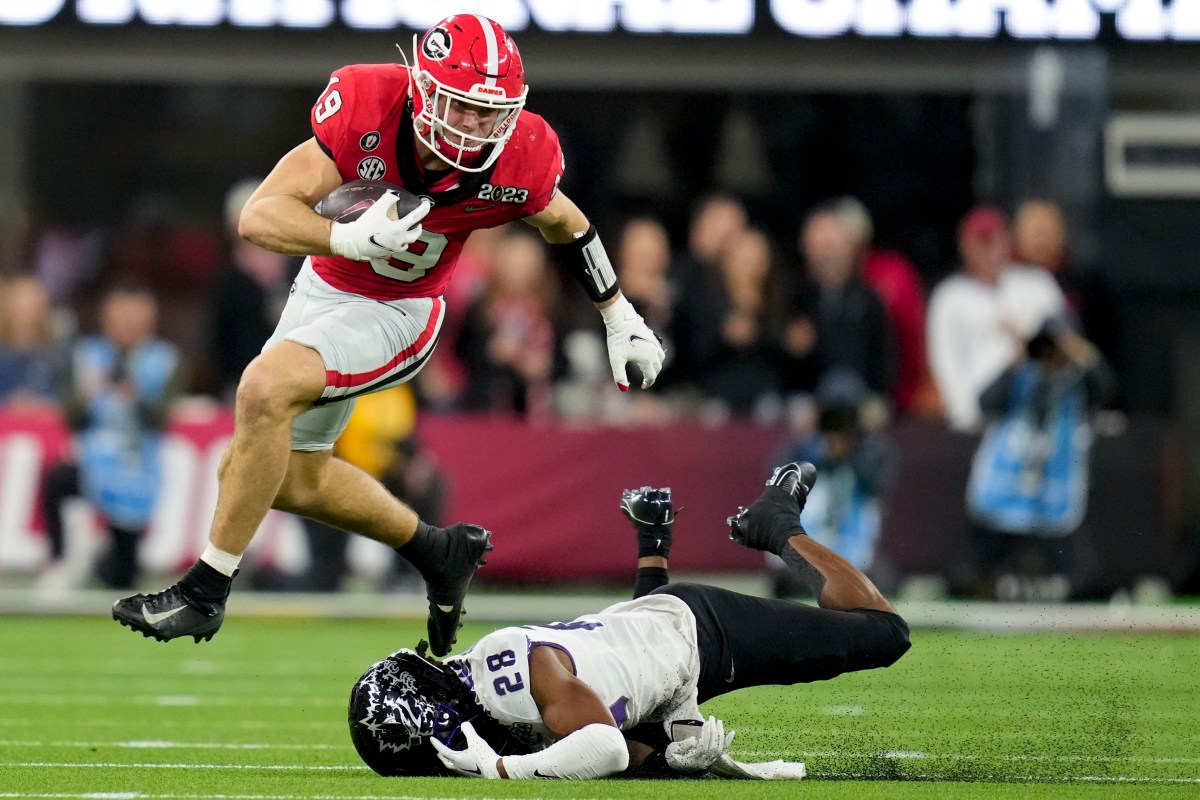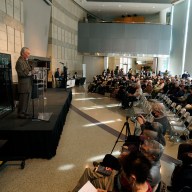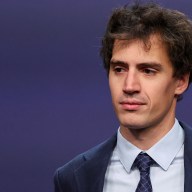TORONTO – As MuchMusic marks its 25th anniversary this month, there will be no stylishly produced retrospectives, no neon-splashed ’80s videos from the vault, and no nostalgic appearances by former VJs.
In fact, representatives from the network – which has survived by keeping a finger firmly on the pulse of young people – say they will not mark the milestone at all, arguing that their audience just doesn’t care about it.
“We will be doing absolutely nothing for the 25th anniversary,” said Brad Schwartz, senior vice-president and general manager of Much MTV Group.
“It’s actually really, really important to me. … You will not see a press release from us, they will not do anything special on air, there will be nothing going on, you will never know that Much turned 25, because for us it’s not a story.
“We are in the looking-forward business, we are in the looking-at-today business, we are in the young-person business. We are not in the looking-back business.”
And, apparently, business is good.
Schwartz says MuchMusic was the No. 2 network for 12-to 34-year-olds last year, behind TSN. Overall ratings steadily increased until 1997 and have held steady since, despite an increasingly competitive landscape and the fact that music videos – once Much’s lifeblood – are now available at the click of a mouse.
Schwartz remembers when viewers had to stay glued to their sets to watch the latest offering from their favourite artist – and even sit through videos they didn’t like to get to videos they did.
“Remember, when MuchMusic was playing music videos, it was the only place to get music videos,” Schwartz said.
“You couldn’t get them anywhere else, so you had to tune into MuchMusic and watch the countdown. If you wanted to watch the Michael Jackson ‘Thriller’ video, you had to watch videos six, five, four, three, two and then finally get to it.
“Today, you don’t need to do that. If you want to watch the ‘Thriller’ video, you go online and you watch it, you watch it 10 times in a row. … Today’s music is so on-demand that you don’t need to watch a Beyonce video to get to a Britney video, you can just go straight to a Britney video.”
As a result, videos have largely been pushed to the margins of the network’s programming. Meanwhile, Much has found higher ratings with in-house fare such as “Video on Trial,” in which comics poke fun at popular videos; reality shows including “So You Think You Can Dance” and “Pimp My Ride;” and with teen dramas including “One Tree Hill” and “Degrassi.”
Much still devotes 50 per cent of its programming to music videos, as per the requirements of its CRTC licence. But once-beloved Much mainstays such as “The Wedge” and “Rap City” have been relegated to late-night airings – where the network tends to tuck much of its video-centric programming – while “The NewMusic” was cancelled outright in 2008.
Unsurprisingly, many Canadian artists lament Much’s change in direction.
“Definitely, they’ve been playing a lot more reality TV programming, and I’m not really a fan of that,” Billy Talent guitarist Ian D’Sa said in a recent interview.
“Or even pop culture TV programming,” added the band’s bassist, Jon Gallant. “They’re a smash success, I guess they’re just following the money, but it’s kind of a drag.”
Said Alexisonfire vocalist George Pettit: “Sometimes you just feel like you’re missing out on what’s the best of our culture, and we’re trading that for ‘Hogan Knows Best.”‘
Rheostatics singer Dave Bidini was more blunt.
“I don’t think MuchMusic contributes to youth culture anymore,” he said. “I think it’s let Canada down in a lot of ways. It’s becoming this teenage lifestyle channel as opposed to an outlet for great, wild, strange, interesting, beautiful music.”
Even John Roberts – one of the network’s first VJs, when he went by J.D. – says he misses long-cancelled music-centric shows such as “City Limits” and “The Power Hour.”
“I lament the loss of the shows, because when we first were on the air it was all about the music, it was all about exposing new talent to the audience,” said Roberts, now the anchor of CNN’s “American Morning,” on the line from his New York office.
“I guess I am somewhat saddened by the fact that a lot of what was supposed to be quote ‘music television’ has gone into reality TV mode. And I know that people probably just got bored of the videos, but I’ll tell you … I just like listening to and watching music, and you can keep the reality shows, I’m not really interested in those at all.”
Videos, of course, have not disappeared from MuchMusic’s repertoire. The station’s website has more than 14,000 music videos, interviews and clips available for free. And Much also owns cable networks MuchVibe, MuchMoreRetro, MuchLoud and PunchMuch, which will be going commercial-free in the fall.
But as far as the main network is concerned, has the Internet killed the music-video station?
“It’s almost like, why would you want to watch a channel of videos and wait and hope something you like comes on, when you have control now?” said Edmonton hip-hop artist Roland Pemberton, a.k.a. Cadence Weapon.
“It’s kind of disappointing that there’s not more of a music focus on a music channel, but they’ve gotta go with what people are watching.”
Added Dallas Green, guitarist/vocalist for Alexisonfire: “I can appreciate what (MuchMusic) was before the Internet and before reality TV, because I remember it and it meant a lot to me … but things change, and it’s all about how I think you change with it.”
So, what changes are next, and where is the station headed? The altered music landscape – and overall direction of MuchMusic over the past decade – might indicate that the station will continue to move away from music, or, at least, music videos.
But executives at the station insist that’s not the case.
“I think music is always going to be a part of MuchMusic, yes,” said Craig Halket, senior music programmer for Much MTV Group. “I don’t see that changing. I think the evolution is going to continue, but music isn’t going away.”
Schwartz has lots of ideas for the future of the network, saying the network needs to get smarter at presenting music videos.
He suggests showing music videos in commercial breaks between programs, or showing 30-second clips of music videos and directing viewers online to watch the rest.
He also says that campaigning the CRTC to have Much’s licence changed is not out of the question.
“We constantly need to evolve the channel along with the desires of young people,” he said. “If our licence doesn’t allow us to be everything that our audience wants us to be, then obviously we have to look at that.
“But I can’t tell you that we have any firm plans or anything on paper that anything’s coming, but we will always have to evolve with our audience.”
Schwartz considers the mandate for the modern MuchMusic to be an “excitement channel,” dedicated to connecting with youth and connecting youth to music.
One need only look to Much’s headquarters on Toronto’s Queen Street West on a typical afternoon to get an idea of whether they’re succeeding.
For a recent appearance by dimpled teen-popper Justin Bieber, screaming throngs of preteen girls crowded the corner, digital cameras fastened to their wrists.
“It’s crazy,” Bieber muttered, over and over.
Heck, the mostly preteen “MuchOnDemand” crowd was so amped to be in the Much building, they even mustered appreciative cheers when recent guest Quentin Tarantino cited long-dead Italian director Sergio Leone as a primary influence (“whoo!”).
These are Schwartz’s people. He’s not too concerned with whether the Much of today stacks up to nostalgic memories of the Much of yesterday – which is why the network doesn’t feel the need to promote its past.
“My friends come to me and they say: ‘Oh, MuchMusic isn’t what it used to be,”‘ he said. “I’m like: ‘You’re 36 years old, you’re not supposed to be watching MuchMusic anymore.’
“If we’re doing our job properly, then we’re staying focused on our audience, which is the ripping, burning, young, early adopter young Canadians.
“So to people who don’t think that we are what we used to be, I’d say we’re even more and greater – we’re just not for you anymore. And if we’re doing our jobs right, we shouldn’t be.”















